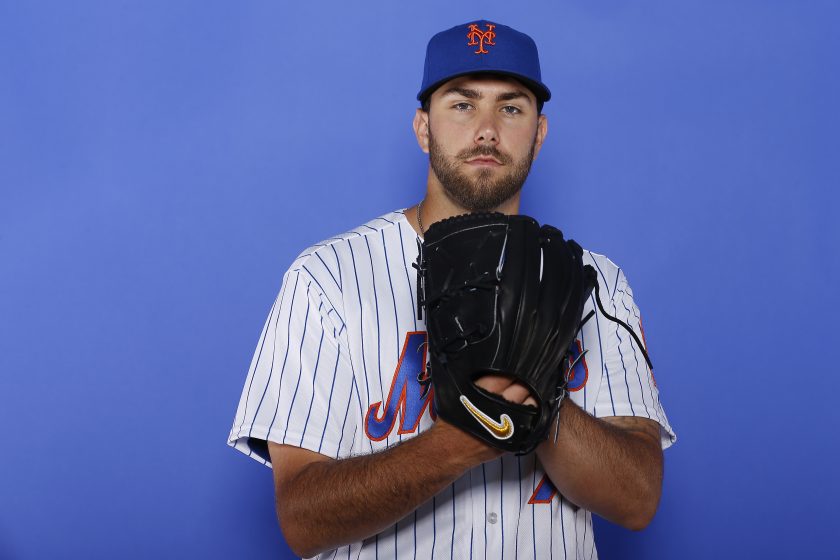New York Mets’ David Peterson could have an impact on the 2020 campaign

Following the loss of Noah Syndergaard, David Peterson could step up during his major league debut with the New York Mets.
Before spring training was officially canceled, the New York Mets were slated to have one of the best starting rotations throughout the majors.
That all changed very quickly.
Just two weeks after the sports world halted, the Mets announced that Noah Syndergaard would require Tommy John surgery and be sidelined until the 2021 season. As a result, New York will now be without one of their best pitchers during a crucial campaign.
Despite the loss of Thor, one of the Mets’ top pitching prospects could provide a spark to their 2020 roster. In theory, there’s a very good chance that David Peterson could make his major league debut later this year.
While the 24-year-old isn’t on the 40-man roster, New York could easily add him before the Rule 5 Draft next winter. This is due to the fact that Syndergaard will ultimately be placed on the 60-day injured list. This would allow the left-hander to be one of the first recalled pitchers if one of the major-league arms suffers a health-related setback.
Prior to the cancelation of spring training, the 6-foot-6 starter was already impressing some of the Mets coaches. Over his three appearances, he threw six innings and recorded a 1.50 ERA and 1.33 WHIP. He additionally struck out six batters and walked three.
Peterson has been rapidly climbing through the Mets minor-league system since they drafted him. The ballclub ultimately selected him in the first round in 2017. The Oregon product was assigned to Low-A Brooklyn after he was selected and was playing for Double-A Binghamton in just two seasons.
Last year with the Rumble Ponies, Peterson completed 116 innings and produced a 4.19 ERA, 3.19 FIP, 2.91 xFIP, 1.34 WHIP, .262 OPP AVG, 24.5% strikeout rate and 7.4% walk rate over 24 starts. In addition, the former first-round selection also produced an impressive 52.6% groundball rate in 2019.
Throughout his minor-league career, the No. 10 top prospect within the Mets system, according to MLB Prospect Watch, has been very effective at creating a high number of ground balls. During the 2018 campaign, his 64.5% groundball rate ranked third-best among all qualified pitchers throughout the minor leagues.
In comparison to Peterson’s groundball rate from last season, it would’ve ranked sixth-best among all starting pitchers in the majors with at least 160 innings pitched. Based on this metric, he profiles similar to Marcus Stroman’s ability to induce high numbers in those regards.
Like Stroman, Peterson’s ability to generate ground balls is due to his low-90s sinker. In 2019, the lefty’s sinking fastball sat between 89-91 mph and at times it touched 93 mph. Furthermore, the control that he has with his sinker could alone carry him to the major leagues in 2020.
While his groundball rate lowered by 11.9% last season, he turned some of those ground balls into strikeouts. As a result, his strikeout rate increased by 2.5% during his third season in the minors.
Despite the success that Peterson has had with his sinker, his mid-80s slider has arguably been his best pitch over the last few seasons. Paired with his sinking fastball, his wipeout breaking ball is extremely effective at creating swings and misses.
Along with these two pitches, Peterson also features a mid-80s changeup and a curveball. He hasn’t experienced much success with either of those two pitches though. Therefore, he’ll need to refine at least one of them to remain a starter at the major-league level.
Since baseball may not resume until at least mid-May, MLB’s hiatus is likely going to delay Peterson’s major league debut. Although, there’s still a really good chance he reaches the majors this season. Especially considering Syndergaard will be out until the 2021 campaign.
Since Peterson was assigned to Triple-A Syracuse earlier this spring, this season-ending injury to Syndergaard probably won’t provide him with an opportunity to break camp with the Mets. Nonetheless, manager Luis Rojas referred to him as their “seventh starter” throughout spring training.
These comments from the first-year manager suggest that Peterson has already gained a lot of trust from the coaching staff. Thus, he’ll likely be near the top of their minor-league depth chart this season.
Without Syndergaard, the Mets rotation is slated to feature Jacob deGrom, Rick Porcello, Steven Matz, Michael Wacha and Stroman in 2020. If any of these pitchers miss a start, then Peterson is likely going to be the first guy recalled.
Previously, the highly-touted thrower would’ve been ready to make his major league debut sometime in June or July. The league will likely push Opening Day back to this summer though, so his debut would possibly have to wait until August.
Even though Peterson would benefit from making at least five starts in Triple-A this season, he’s already proven that both his sinker and slider are major-league ready. So if needed, he’d likely be capable of serving as an injury replacement at the start of the season.
The Mets still have a chance to surge back into the playoffs in 2020 even without Syndergaard. In order to fill the void, New York could eventually turn to Peterson to complete the rotation.






